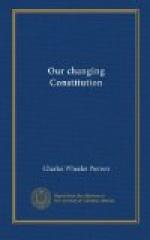[Footnote 1: Act of September 1, 1916, 39 Stat., 675.]
[Footnote 2: Hammer v. Dagenhart, 247 U.S., 251.]
The distinction drawn by the majority of the Court between this and previous decisions was a narrow one and its validity has been questioned by some writers. It has nowhere been more clearly explained than in an address delivered before a body of lawyers by a former member of the Court.[1] Mr. Hughes said:
There has been in late years a series of cases sustaining the regulation of interstate commerce, although the rules established by Congress had the quality of police regulation. This has been decided with respect to the interstate transportation of lottery tickets, of impure food and drugs, of misbranded articles, of intoxicating liquors, and of women for the purpose of debauchery. It was held to be within the power of Congress to keep “the channels of interstate commerce free from immoral and injurious uses.” But the Court in this most recent decision has pointed out that in each of these cases “the use of interstate commerce was necessary to the accomplishment of harmful results.” The Court, finding this element to be wanting in the Child Labor Case, denied the validity of the act of Congress. The Court found that the goods shipped were of themselves harmless. They were permitted to be freely shipped after thirty days from the time of removal from the factory. The labor of production, it was said, had been performed before transportation began and thus before the goods became the subject of interstate commerce.
The fundamental proposition thus established is that the power over interstate commerce is not an absolute power of prohibition, but only one of regulation, and that the prior decisions in which prohibitory rules had been sustained rested upon the character of the particular subjects there involved. It was held that the authority over interstate commerce was to regulate such commerce and not to give Congress the power to control the states in the exercise of their police power over local trade and manufacture.
[Footnote 1: Charles E. Hughes, President’s Address, Printed in Year Book of New York State Bar Association, Vol. XLII, p. 227 et seq.]
Congress did not receive this decision of the Supreme Court submissively. On the contrary, plans were laid to nullify it. The effort to legislate on child labor under cover of the power to regulate commerce having failed, recourse was had to the constitutional grant of power to lay taxes. Within six months after the decision of the Supreme Court declaring the act unconstitutional was announced, another statute similar in purpose and effect was enacted as part of a Federal Revenue Act.[1] This act provided for an additional tax of ten per cent. of the net profits received from the sale or distribution of the product of any establishment in which children under the age




